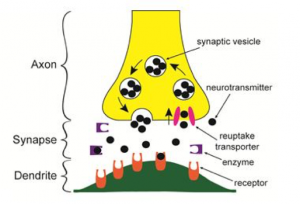Neurotransmitters are chemical messengers that help relay information throughout the body. They transmit information through specialized nerve cells called neurons. How this works is that a signal is sent from the beginning of neuron (called the dendrite) to the other end (called the axon). At that point, information can be sent to other neurons via the release of neurotransmitters.
 Neurotransmitters are released from the axon and must travel across a small space (called a synapse) where they can dock with receptors on one or more other neurons to keep the information flowing. Once the information has been sent, neurotransmitters travel back across the synapse where they can be taken back into the axon (via a gate called a reuptake transporter) where they are safe from destruction and can be used again when necessary.
Neurotransmitters are released from the axon and must travel across a small space (called a synapse) where they can dock with receptors on one or more other neurons to keep the information flowing. Once the information has been sent, neurotransmitters travel back across the synapse where they can be taken back into the axon (via a gate called a reuptake transporter) where they are safe from destruction and can be used again when necessary.
The Importance of Neurotransmitter Reuptake
The process of moving the neurotransmitters from the synapse back into the axon of the neuron is called “neurotransmitter reuptake”, and it plays a crucial role in long-term health. When neurotransmitters are in the synapse (the space between neurons) they are exposed to a number of enzymes (including monoamine oxidase (MAO) and catechol-O-methyl transferase (COMT)) that metabolize (i.e., degrade/destroy) the neurotransmitters. The longer a neurotransmitter stays in the synapse, the more likely it is to be destroyed by one of these enzymes.
The Problem with Reuptake Inhibitors
Herein lies one of the major downsides to many medications that are traditionally used to alter neurotransmitter function – including selective serotonin reuptake inhibitors (SSRIs), selective norepinephrine reuptake inhibitors (SNRIs), norepinephrine reuptake inhibitors (NRIs) and tricyclic antidepressants.
These drugs block the reuptake of one or more neurotransmitters by binding with the reuptake transporter. This provides a temporary increase in the amount of neurotransmitter present in the synapse, which can provide short-term relief of symptoms associated with neurotransmitter imbalance, including depression, anxiety, focus, concentration and memory.

Figures taken from the National Institue of Drug Abuse website: www.drugabuse.gov
However, it also exposes these neurotransmitters to degradation over time by the MAO and COMT enzymes, which can cause further depletion in these neurotransmitter with time. For some people, this can occur in hours; with others it may take years. When it does happen, it usually appears that the drugs “quit working”.

| Baseline | During Reuptake Inhibition | After Reuptake Inhibition (Over time) |
Once this additional depletion has occurred due to the use of reuptake inhibitors, a person feels worse than they did when they originally started the medications and they often require more aggressive interventions in order to correct these imbalances.
Correcting Depletion Due to Reuptake Inhibitors
The only known way to increase the total amount of neurotransmitter in the system is through amino acid therapy. Amino acid therapy involves providing the body the building blocks that it needs to make more neurotransmitters. Over time, this will restore depleted neurotransmitter levels in the axon as well as provide sufficient neurotransmitter in the synapse to optimize function and eliminate symptoms due to neurotransmitter imbalance and/or neurotransmitter reuptake inhibition.


THANK YOU!! This is the first site I could find that explains “reuptake” in a way this layman could understand. Most appreciated.
Hi Chas – I’m glad you found the site/post helpful!!
Sincerely,
Dr. Chad
I would like to agree with this. Sinple explained 🙂
Thank you 🙂
Thank you so much for the simple but effective way to explain, from the Netherlands, City of Nijmegen
Thanks for the comment Chris – I’m glad you found the post useful!
Dr. Chad
Thanks for the enlightenment of one of the major issues of solving addiction to chemicals.
You are very welcome Bill – I’m glad you found the post useful –
Dr. Chad
Perfectly understandable explanation. Many thanks.
Thanks for the comment Melissa – I’m glad you found it helpful!
Sincerely,
Dr Chad
Thank you for explaining this. I did not understand the science behind the medications I am taking.
You are very welcome! I am glad you found the post useful:)
Sincerely,
Dr Chad
I’ve read that people with Attention Deficit Disorder syndrome also have problems with the process of neurotransmitters release and reuptake. Can you explain those problems, pls? Thx before…
Hi Amy – thanks for the comment/question; here is a paper that should provide some more insight: https://neurosupport.com/wp-content/uploads/2015/11/07_adhd_final.pdf
I hope this helps!
Sincerely,
Dr. Chad
I wholeheartedly concur with all the previous comments. I’ve been on various ssri medications for many many years now, currently Citalopram (20mg). I suffer from Cerebellum A-taxis, needing a stick to walk the short distances I can. I recently came across a medication called Buspirone which I was informed increases Seratonin in the Cerebellum thus decreasing the A-taxis symptoms. Would you concur with this Dr Oler?
Regards: Rob Borg.
Hi Bob,
Thanks for the feedback. I know of only one study using buspirone with cerebellar ataxis, and it did show some benefit. However, I would debate the proposed mechanism of action, as buspirone works on both serotonin and dopamine receptors. It is just as likely that it is the effect on the dopamine receptor (or possibly a combination of effects on both serotonin and dopamine receptors) that helps resolve the ataxia. It would not be unlike using dopamine precursors (in balance with serotonin precursors) to help optimize functioning of those with Parkinson’s disease, including improvements in balance, gait, physical coordination and extremity control. While I know of no studies involving the use of amino acid therapy and cerebellar ataxis, it may be worth looking into.
To learn more, please visit: http://naturalsolutionsforparkinsonsdisease.com/. To find a provider that may be able to help, contact NeuroResearch: http://www.neurosupport.com.
Sincerely,
Dr. Chad
How would I cite this page I am using some of the Information for a paper
Hi Toshche – you can just include the link; I’m glad you found the information helpful – what is your paper about?
Sincerely,
Dr. Chad
Thank you for your clear article. I have been taking Passiflora Incarnata (Passion flower) for several years and a natural health practitioner advised that I m slowly depleting my brain reserves of GABA because passiflora has GABA reuptake inhibiting properties.
Now I can see clearly why thanks to the explanations above.
Many thanks.
I’m glad you found the post useful Chris –
Sincerely,
Dr Chad
Many spelling and grammatical errors in your article. That really takes away from your credibility. I suggest an edit soon. Overall, good information but a warning should be issued for people that are on SSRI’s to NOT start amino acid therapy without talking to their doctor. The combination could be lethal!
Hi Robert – thanks for the comment. I wasn’t aware that we had grammatical errors on the page and will certainly have someone look into this. We have not found serotonin syndrome to be an issue when the amino acids are given in proper doses and under the guidance of an experienced provider. You can learn more here: http://amino-acid-therapy.com/medications-and-amino-acid-therapy/.
Sincerely,
Dr Chad
Could you tell me what amino acids should be used? I’ve been on antidepressants since 1994, and I want to find some way to actually increase what my brain needs naturally. I had read about the amino acids, but I’m not sure which one’s I would need to take and the amounts.
Hi Kristi,
Thanks for the comment; we have found that the blend of amino acids needs to be customized to each person’s needs, so there isn’t a standard ‘formula’ to use. Most people start with a 10:1 ratio of L-tyrosine to 5-HTP, but even then, the amounts can vary dramatically. I suggest you contact NeuroResearch and find a provider that can guide you: http://www.neurosupport.com.
Good luck!
Sincerely,
Dr Chad
Hello Dr. The information is very educative. In the brain of a normal patient, do the neurotransmitters have to be reabsorbed or they neurotransmitters are constantly produced as needed. Pls throw light on the reuptake process in normal and depressed brains. Thanks
Hi Iro,
Thanks for the comment; the actual workings of neurotransmission are not as straight forward as we would necessarily like (nor as well known as we would expect) but the basic premise goes something like this: most neurotransmitters are excreted into the synapse, dock with a receptor on the post-synaptic neuron, then return to the presynaptic neuron for reuptake where they can do this process all over again many times. Some of the neurotransmitter in the synapse gets metabolized (i.e., broke down and eliminated) by various enzymes (including MOA and COMT enzymes), so the body must manufacture some from their precursor amino acids on a regular basis.
When neurotransmitter dysfunction occurs, it can be because of one or more reasons, including: nutritional deficiency (where the body doesn’t have enough raw materials to make sufficient amounts of one or more neurotransmitters), neurotoxicity (where neurons are destroyed due to physical or chemical harm) or receptor malfunction (where neurotransmitter receptors on the post-synaptic neurons do not function properly). Any of these processes will result in improper neurotransmitter transmission, resulting in one or more symptoms of imbalance: http://amino-acid-therapy.com/neurotransmitters/imbalances-cause-disease-symptoms/.
We can use amino acid therapy to correct (in the case of nutritional deficiency and some cases of receptor malfunction) or compensate (in the case of neurotoxicity) for the neurotransmitter dysfunction, which eliminates or significantly reduces any symptoms due to the imbalance(s).
Hope that helps!
Dr Chad
Great site. I just read an interesting article not long ago where they did a head to head study with curcurmin and it was just as effective as prozac(and not saying prozac is THAT effective anyway, esp long term as you explain why nicely but.. point being, the hypothesis is that there is a relationship with brain inflammation and depression. Not that everyone depressed should run out and start taking a turmeric based supplement(and please if you do get a good quality one recommended by a practitioner), but still much to be discovered. Thank you. I wish I had the study to post for your reading enjoyment.
Hi Diana – thanks for the comment; this is likely the study you are referring to: https://www.ncbi.nlm.nih.gov/pubmed/23832433. The placebo effect with depression can be very large and significant, but it will be interesting as new data comes out over the next few years to help identify the pathways/etiology of depression and how we can successfully address those pathways using natural methods.
Sincerely,
Dr. Chad
After taking ssri does the blocking ever goes away.
Hi Kadeem,
That is a great question. Most of the time, as the the medication works out of a person’s system, the effects of the drug will be lessened – this can take 6 weeks or more in some cases.
However, some people experience lasting symptoms. In our experience, this is usually due to (a) receptor damage and/or (b) neurotransmitter imbalance. Either way, the neurotransmitter function has to be restored in order to alleviate symptoms. Amino acid therapy can be a big help in these circumstances.
If you aren’t currently working with a provider that specializes in amino acid therapy, contact NeuroResearch to see if there is a provider near you that can help. If not, you can contact us to get on our waiting list.
Good luck!
Sincerely,
Dr Chad
Thank you for this clear and concise explanation! I would just suggest adding something detailing how in most cases neurons do not regenerate and that is the issue with the degradation of neurons in the synapse and the amount of time they are in the synapse.
Thanks for pointing that out Joseph – you are quite correct.
Sincerely,
Dr Chad